5 books about Body art
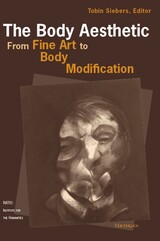
The Body Aesthetic
From Fine Art to Body Modification
Tobin Siebers, Editor
University of Michigan Press, 2000
The last thirty years of cultural theory have seen a vigorous analytic focus on the human body both as the subject of cultural representations and as an escape from their repressive influence. Rare is the account that focuses on the most obvious fact about the body: it is the stuff out of which human beings are made.
Generously and variously illustrated, this volume gathers together the work of literary critics and artists, classicists, art historians, and specialists on the history of the body, who survey the strangeness and variety with which the body has given human beings form. Richard Leppert traces how the representation of little girls responds directly to the cultural anxieties of modernity. René Girard plots how starvation becomes an art form, while Eric Gans surveys the contemporary phenomenon of body modification. Sander Gilman explores aesthetic surgery as a response to human unhappiness. Simon Goldhill discovers in the Roman empire the initial stirrings of institutions that focus on the spectacle of the body, and Cynthia S. Greig provides a glimpse of what the history of photography would look like if male nudes replaced female ones. Marion Jackson details how the different physical existence of the Inuit guides the way they make art. Joseph Grigely transforms aesthetics as usual by focusing on the disabled body, while Tobin Siebers describes the traumatic appeal in both fine art and the media of wounded flesh, whether human or animal.
The Body Aesthetic is a broad exercise in cultural studies and will address a variety of readers, from those interested in detailed, theoretical accounts of the body, to those interested in belles lettres, to those interested in fine art.
Tobin Siebers is Professor of English, University of Michigan.
Generously and variously illustrated, this volume gathers together the work of literary critics and artists, classicists, art historians, and specialists on the history of the body, who survey the strangeness and variety with which the body has given human beings form. Richard Leppert traces how the representation of little girls responds directly to the cultural anxieties of modernity. René Girard plots how starvation becomes an art form, while Eric Gans surveys the contemporary phenomenon of body modification. Sander Gilman explores aesthetic surgery as a response to human unhappiness. Simon Goldhill discovers in the Roman empire the initial stirrings of institutions that focus on the spectacle of the body, and Cynthia S. Greig provides a glimpse of what the history of photography would look like if male nudes replaced female ones. Marion Jackson details how the different physical existence of the Inuit guides the way they make art. Joseph Grigely transforms aesthetics as usual by focusing on the disabled body, while Tobin Siebers describes the traumatic appeal in both fine art and the media of wounded flesh, whether human or animal.
The Body Aesthetic is a broad exercise in cultural studies and will address a variety of readers, from those interested in detailed, theoretical accounts of the body, to those interested in belles lettres, to those interested in fine art.
Tobin Siebers is Professor of English, University of Michigan.
[more]
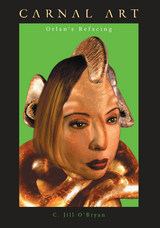
Carnal Art
Orlan’s Refacing
C. Jill O'Bryan
University of Minnesota Press, 2005
The French artist Orlan is infamous for performances during which her body is surgically altered. In nine such performance surgeries, features from Greek goddesses painted by Botticelli, Gérard, Moreau, and an anonymous School of Fontainebleau artist, as well as from da Vinci’s Mona Lisa, were implanted into Orlan’s face. During her surgical performances, viewers witness a material tampering with the relationship between the face and individual identity, the original and the constructed, a historical critique of the association of art with beauty and the female body.Responding to Orlan’s definition of her performance surgeries as “carnal art,” C. Jill O’Bryan considers how the artist’s ever-fluctuating reconstructions of her face question idealized beauty and female identity, persuasively arguing that Orlan’s surgically reinvented face succeeds in both reinforcing and breaking apart corporeal subjectivity and representation. O’Bryan contextualizes Orlan’s operations within the centuries-long history of public dissections and surgeries, lavish anatomical illustrations created to draw the gaze into the opened anatomy, Artaud’s “Theater of Cruelty” in the early twentieth century, and contemporary works and performances by Cindy Sherman, Hans Bellman, and Annie Sprinkle. A compelling blurring of the line between feminist theory and art criticism, O’Bryan’s close examination of Orlan’s performance surgeries complicates and reconfigures the notion of identity—and its relation to the body—at the very boundary dividing art from identity.C. Jill O’Bryan is an independent scholar and artist who has written and lectured widely on Orlan in particular and body art in general.
[more]
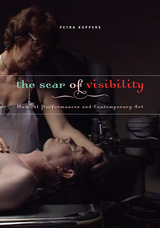
The Scar of Visibility
Medical Performances and Contemporary Art
Petra Kuppers
University of Minnesota Press, 2007
Contemporary visual and performance artists have adopted modern medical technologies such as MRIs and computer imaging—and the bodily access they imply—to reveal their limitations. In doing so they emphasize the unknowability of another’s bodily experience and the effects—physical, emotional, and social—of medical procedures.In The Scar of Visibility, Petra Kuppers examines the use of medical imagery practices in contemporary art, as well as different arts of everyday life (self-help groups, community events, Internet sites), focusing on fantasies and “knowledge projects” surrounding the human body. Among the works she investigates are the controversial Body Worlds exhibition of plastinized corpses; video projects by Shimon Attie on diabetes and Douglas Gordon on mental health and war trauma; performance pieces by Angela Ellsworth, Bob Flanagan, and Kira O’Reilly; films like David Cronenberg’s Crash and Marina de Van’s In My Skin that fetishize body wounds; representations of the AIDS virus in the National Museum of Health and on CSI: Crime Scene Investigations; and the paintings of outsider artist Martin Ramírez.At the heart of this work is the scar—a place of production, of repetition and difference, of multiple nerve sensations, fragile skin, outer sign, and bodily depth. Through the embodied sign of the scar, Kuppers articulates connections between subjective experience, history, and personal politics. Illustrated throughout, The Scar of Invisibility broadens our understanding of the significance of medical images in visual culture.Petra Kuppers is associate professor of English at the University of Michigan, Ann Arbor, and the author of Disability and Contemporary Performance: Bodies on Edge.
[more]
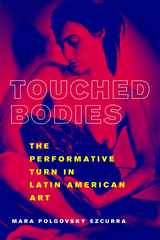
Touched Bodies
The Performative Turn in Latin American Art
Mara Polgovsky Ezcurra
Rutgers University Press, 2019
Shortlisted for the 2020 Association for the Study of the Arts of the Present Book Prize
Winner of the 2019 Art Journal Prize from the College Art Association
What is the role of pleasure and pain in the politics of art? In Touched Bodies, Mara Polgovsky Ezcurra approaches this question as she examines the flourishing of live and intermedial performance in Latin America during times of authoritarianism and its significance during transitions to democracy. Based on original documents and innovative readings, her book brings politics and ethics to the discussion of artistic developments during the “long 1980s”. She describes the rise of performance art in the context of feminism, HIV-activism, and human right movements, taking a close look at the work of Diamela Eltit and Raúl Zurita from Chile, León Ferrari and Liliana Maresca from Argentina, and Marcos Kurtycz, the No Grupo art collective, and Proceso Pentágono from Mexico. The comparative study of the work of these artists attests to a performative turn in Latin American art during the 1980s that, like photography and film before, recast the artistic field as a whole, changing the ways in which we perceive art and understand its role in society.
Winner of the 2019 Art Journal Prize from the College Art Association
What is the role of pleasure and pain in the politics of art? In Touched Bodies, Mara Polgovsky Ezcurra approaches this question as she examines the flourishing of live and intermedial performance in Latin America during times of authoritarianism and its significance during transitions to democracy. Based on original documents and innovative readings, her book brings politics and ethics to the discussion of artistic developments during the “long 1980s”. She describes the rise of performance art in the context of feminism, HIV-activism, and human right movements, taking a close look at the work of Diamela Eltit and Raúl Zurita from Chile, León Ferrari and Liliana Maresca from Argentina, and Marcos Kurtycz, the No Grupo art collective, and Proceso Pentágono from Mexico. The comparative study of the work of these artists attests to a performative turn in Latin American art during the 1980s that, like photography and film before, recast the artistic field as a whole, changing the ways in which we perceive art and understand its role in society.
[more]
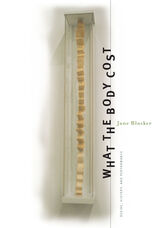
What The Body Cost
Desire, History, And Performance
Jane Blocker
University of Minnesota Press, 2004
READERS
Browse our collection.
PUBLISHERS
See BiblioVault's publisher services.
STUDENT SERVICES
Files for college accessibility offices.
UChicago Accessibility Resources
home | accessibility | search | about | contact us
BiblioVault ® 2001 - 2024
The University of Chicago Press









